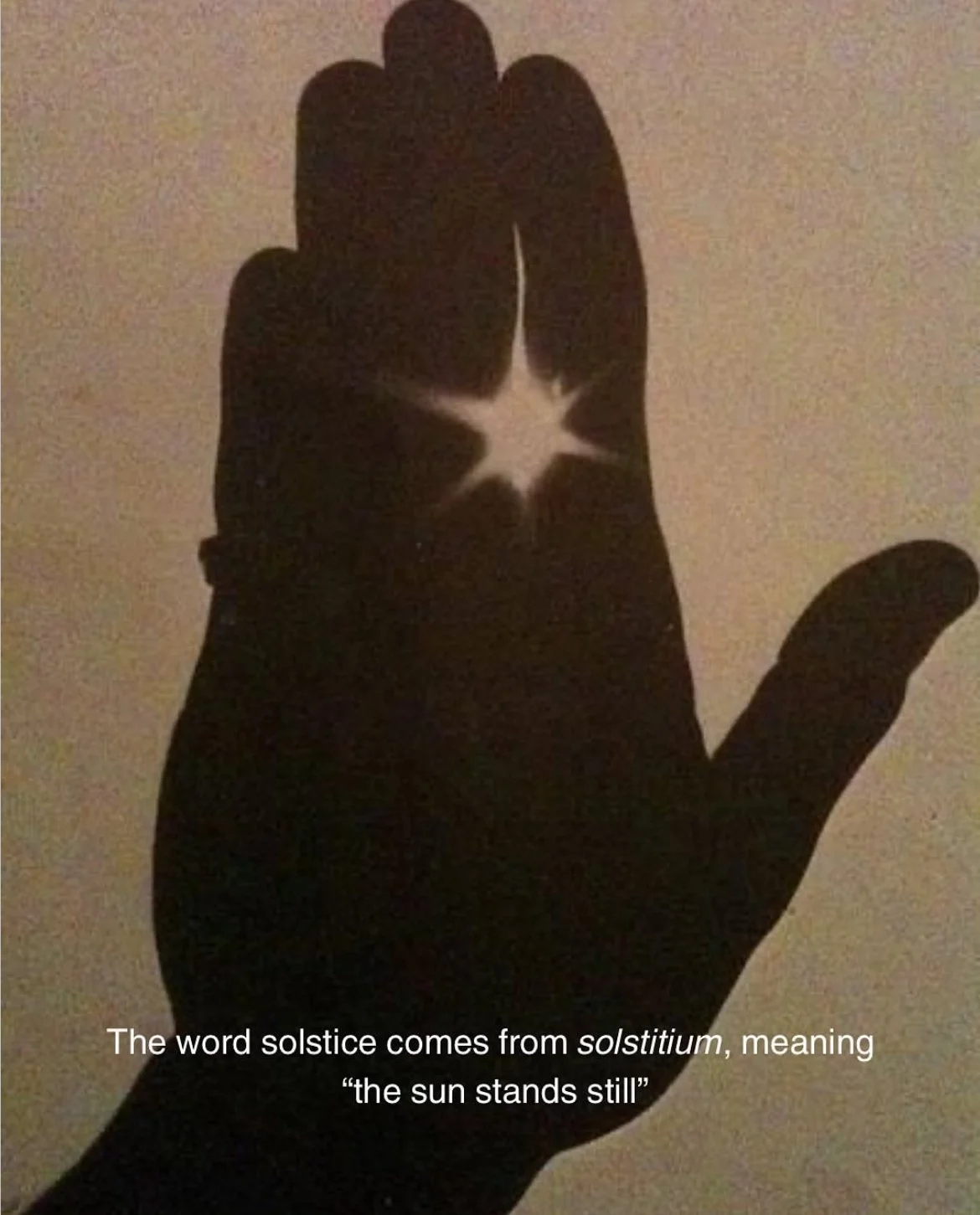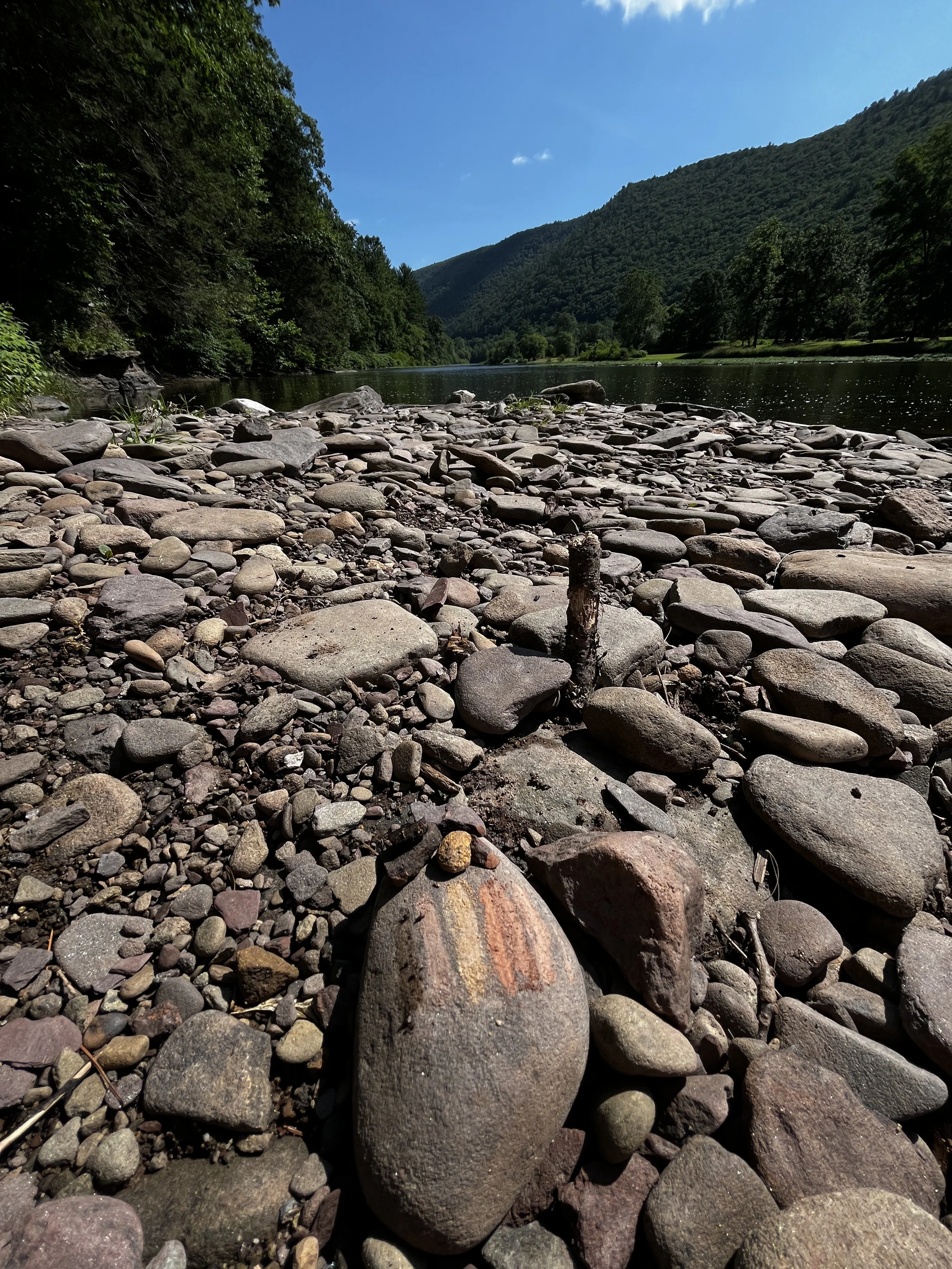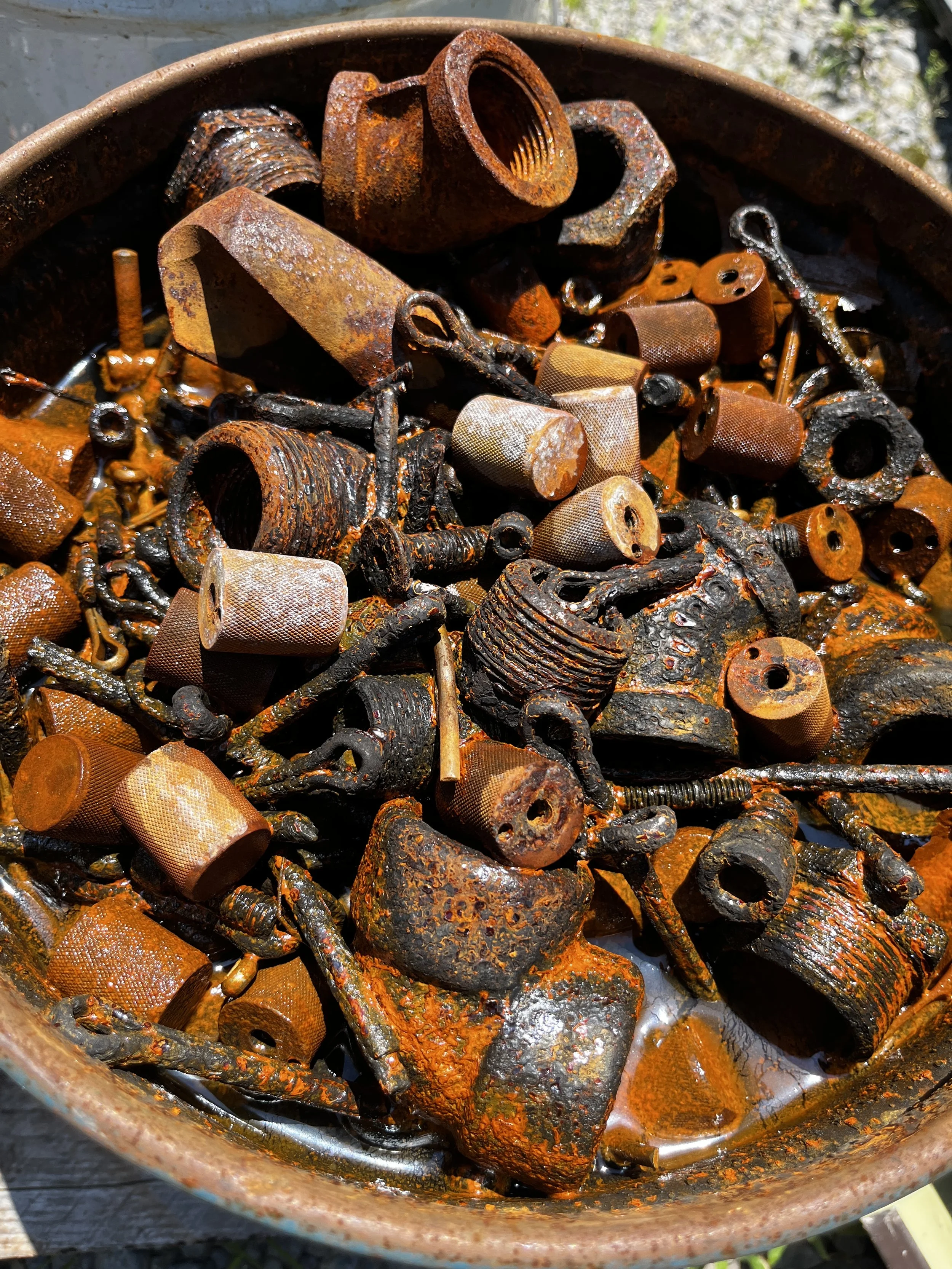PGH PIGMENTS I: Sun, Moon, and Rust
July 17th 2025
Hey.
Every three years or so I think about writing a newsletter. I get so excited to share what I’m working on, what I’m learning - and then some kind of inhibitor pushes it into the depths of my brain. Maybe it’s perfectionism, or unworthiness, or whatever long to-do list is bogging me down for weeks at a time. Maybe it’s the moon. The full moon last week was in Capricorn (while the sun is in Cancer, whatever that means) which apparently calls for a reflection on your commitments. These can be work goals, personal disciplines, or spiritual practices - any mountain you have been climbing, so to speak. It asks for you to show up fully as yourself, releasing perfectionism and grounding in your true values. I’ve been re-committing to my work with water and with pigments, to studying my ancestry, to making my home a sacred space, and to myself and my relationships.
And I’m drawing on the power of the moon to commit to this damn newsletter.
Graphic from @mountsunny on instagram
2025 Summer Solstice
Seasons change. It’s one of my favorite things about living in Pennsylvania. Mulberries fall on sidewalks, ghost pipes emerge from moss, and heat lightning makes the sky appear purple over rolling, green hills. I mean come on, have you smelled that mugwort?? In times of transition, I like to pull one tarot card before and after some marked date. Sometimes my inquiries differ, and my decks differ - I have two. One is an Egyptian Cartouche deck that has been very well-loved, and the second I acquired recently is called Rust Belt Arcana by David Wilson and Matt Stansberry. It’s fucking beautiful. I’ve been acquainting myself with the deck, so on June 22nd I asked the cards, what can I expect in this next season? What’s in store for me? And I pulled the Five of Swords. Adversary. The art features two adult woodpeckers on either side of a tree, observing a snake coming out of the hole where their three babies are living. Now, it’s the year of the snake and at first I wasn’t worried. But as I read on, I couldn’t find many positive interpretations of this card. Conflict, defeat, tension, betrayal. Looks like this season isn’t looking too good for me.
I questioned the possible applications of this adversarial prediction in my life. It could be familial, it could be inner wounds, it could be material loss. I interpreted it as a choice I would have to make, not yet knowing what that choice is about. So I talked to my somatic therapist about it. Yes, we’re woo-woo together. (Two sessions ago she helped me travel to a (my?) Babushka who fed me mugwort and lemon balm and painted me with hematite. Do you want to hear about that?) She suggested I ask the cards for more clarification. So I shuffled, and one card fell out - the Nine of Cups. Wishes fulfilled. What the hell? This card is the complete opposite of the adversary, predicting abundant success and happiness in life. I only feel more confused…and maybe a little more at ease. One of my aspirational practices involves moving through change with ease, support, and gratitude, so maybe this will test all of the tools I’ve been collecting. Who knows.
You may be asking, wtf Sierra, I just wanted to learn more about pigments and now I have to read about tarot and the moon. Well let me tell you, it’s all connected. I cannot work with something as ancient as the Earth while circumventing its magic, its messages, and my own history. I refuse to pick and choose the parts of myself that I want to show up with - my ever-changing self cannot be contained by professionalism and essentialism. Why do you think I broke out of the lab? Certainly not to jump into another constrained practice that had no room for feelings, messiness, and expansiveness. Conventional science is not the sole proprietor of data, fine art is not the center of my world, and I am absolutely rejoicing in the grey areas between disciplines, identities, and time. Pigments contain multitudes, and so do I.
Pigment Proclamation I
I think one of my favorite things about pigments (besides the primal joy of color) is that they are RECORDS - color signatures of a specific place at a specific time. you can glean information from these records such as geologic, ecologic, and industrial histories. Literally. It’s not a stretch - it’s a ‘science’. This craft is a science, its alchemy, its connection to the natural world and wonder and a pilgrimage to our roots as beings not separate from the environment. It transforms separateness into sameness, a radical act in a fascist world at war. It’s anti-imperial to connect, to work with the environment as art and as medicine and as selves, to re-route pathways that have been severed by oppressive forces and technology and capitalism and control. Let go of control, regain autonomy, weave connections, remember oneness with this wild and precious earth during our short time alive. Death and disability is inevitable, we need support, we need love and community, we need to release shame and resistance, we need to send our feeling roots out from our feet and palms into the earth and sky. Suspended as earthly beings who share atoms with botanical molecules and crystalline structures. Drinking water can remember where it comes from, minerals can carry old energies into new spaces, and we can do the same if we treat water and minerals and remembrance as medicine. Can we remember where we came from? Our traditions, our roots, our roles as people with human and earth ancestors? Can we restructure our metabolites to function as they once did when we were more connected? Is this the ‘soul sickness’ that can be treated with hematite and linseed oil for four days? Can our blood remember its origins (the heart of the Earth) with the help of hematite? Of iron? Can rust remind the iron in our bodies to breathe again?
Heidi Gustafson says ochres are defined by iron and oxygen plus something inexpressible.
Breathe here.
Hematite and Gall Ink on Plywood
Alchemy and Spirituality go hand in hand. Jodorowsky emailed the author of this book in 2006 with an amazing quote, “Alchemy, like any process in human life, works to materialize spirit and at the same time spiritualize material. This is a concept that underlies all my artistic creations.” Oh my god, yes! And through this process inventions came to life including gunpowder, ink, paints, dyes…metaphysically significant science. Alchemy centers change, transformation, transmutation, purification. Are we not all alchemists of our own spirits, practices, and materials?
“All that you touch, you Change. All that you Change, Changes you. The only lasting truth is Change. God is Change.”
- Octavia Butler, Parable of the Sower 1993
For me, pigments are a symbol of change. They are transformed by their conditions - time, pressure, and surrounding elements. They adopt a crystallographic structure, only to be broken open again by erosion, by geographic movement, by the hands of pigment-makers and alchemists. Specifically, iron changes in the Rust Belt. Iron ore has a long, long history in these hills, but I think a lot about the industrial boom. I live in the Steel City, I’ve been to Steelers games, I’ve got great granddaddies who worked and died in the mines. I cross crumbling steel bridges every day.
A bucket o’ rust at a big antique barn on the side of the highway in Central PENNA
Rust Belt Arcana by David Wilson & Matt Stansberry
Anarchy and Alchemy
While I was waiting for a COVID test to run at my friend's house, I flipped through their home library. They have a great collection of books from spider anatomy to gender traitor-ism to…an analysis of Alejandro Jodorowsky’s films. I’ve only seen The Holy Mountain, so I flipped to that chapter. It’s a weird fucking movie, if you’ve seen it you either love it or are disgusted and confused, or all of the above. But the motivation behind the movie had more depth than I was aware of, and weirdly aligned with much of what I’ve been studying in my pigment practice.
Across cultures and time, people have always tried to reach the divine through elevation. Physical, geologic elevation that is closer to the atmosphere and the heavens. Enlightenment is sought through climbing, ‘conquering’, mountains. A test of faith and endurance and physical and mental ability. Some of Alejandro Jodorowski’s writings, particularly in the Holy Mountain, made me think of something antithetical to this belief. To find the divine, I go as deep as possible, usually sitting at the bottom of valleys where mountain streams run and erode the mountain walls. The breaking open of these ancient features are much more spiritual to me than summiting an incline to commune with the clouds - while still magical and breathtaking, nothing is like being held in the cradle of the mountain valley.
I was sitting in the middle of Pine Creek in Tiadaughton State Forest (I’m in the middle of a residency on the W Branch Susquehanna River), staring out at the rising moon with my butt on a giant smooth bedrock, thinking about iron. How sitting at the bottom of valleys brings me closer to the Earth, to the iron core and the molten veins that everything else is built from. I realized, is Iron a deity? Is it something I revere, work with, talk to, give offerings to, and look to for support? Not only is iron my friend and guide, but also maybe a deity. How Holy is that? I should make a film called The Holy Valley. I bet Ogun and Sekhmet would like it.
Pine Creek Pigments, Penna
The first step in the steel-making process is reduction - this means that iron oxide compounds are stripped of their oxygen.
Fe2O3(solid) + 3H2(gas) → 4Fe(solid) + 3H2O(gas)
Fe2O3(solid) + 3CO(gas) → 4Fe(solid) + 3CO2(gas)
The result is Fe: iron without oxygen. The process is more variable and complex than this depending on the composition of the iron ore and the intended end product, but essentially, a sort of ’suffocation’ happens for the purpose of industry and infrastructure. More processing happens through heat, added chemicals, physical manipulation, etc etc. People around me usually see rust as a problem that weakens our infrastructure, crumbles our cars, and causes tetanus or general aesthetic unease. But I’ve grown from neutral to obsessed.
Rust is just iron breathing again.
A little air + a little water + a little iron = beautiful magic. Rust finds a way, through rivers and bacteria and petrochemical industries. I like to grow rust in my home with old rail road spikes, nails, and old car parts. I throw bits and bobs in a big jar with acetic acid (white vinegar) and watch it grow on my shelf for years. Different pieces of iron yield slightly different rust properties, but they are all indescribably beautiful.
Alright, I’m done ranting about rust for now - if you made it this far, congratulations. You’re a little weirder now. Oh yeah, I probably should be speaking about my recent art residencies (FolkLab; Pennsylvania Environmental Council) and the Colors of the River program (Three Rivers Waterkeeper) and art-based ecology (shout out to Dr. Woolery) and my future visions for the Pittsburgh Pigment Collective, but those will have to wait. Feel free to reply with hate mail and/or love letters.
With love,
Sierra
sierra@pittsburghpigments.org




